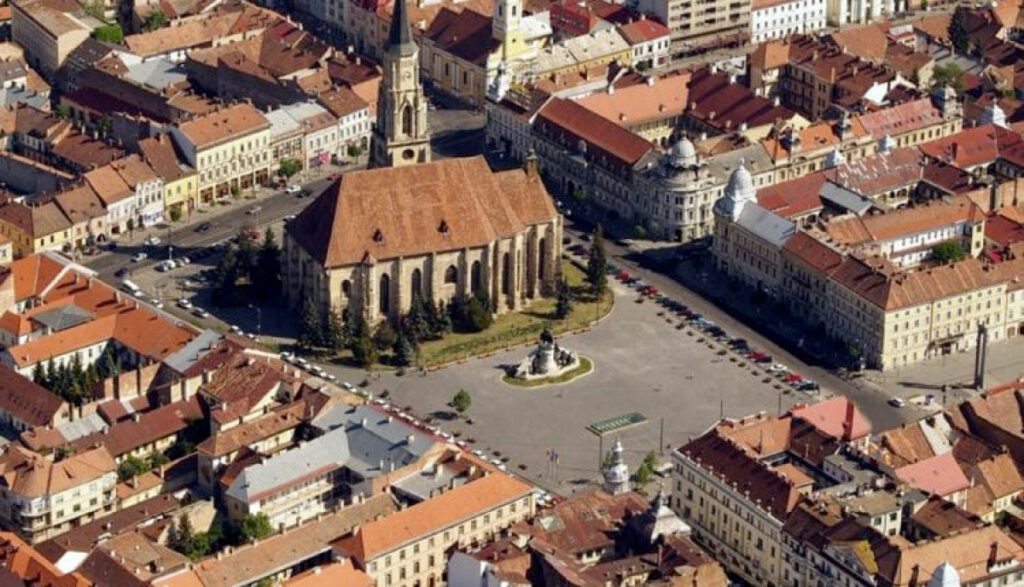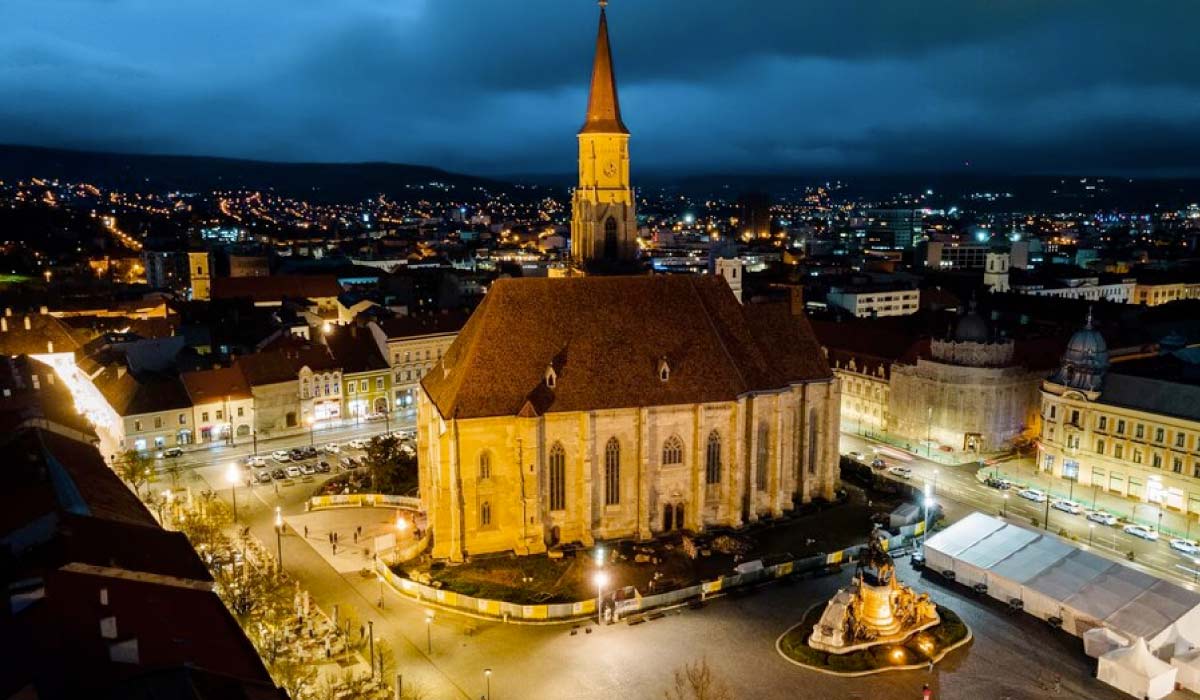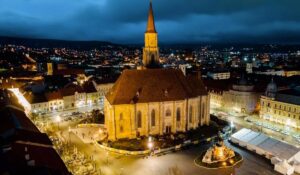Table of Contents
Transylvanian Charm
As you explore deeper into the heart of Transylvania, you will discover a wealth of enchanting folklore and mesmerizing legends that contribute to the area’s irresistible charm.
From stories of vampires to mythical creatures said to wander through the forests, Transylvania is a captivating destination that offers more than just breathtaking landscapes and historic sites.
Whether you have a passion for history or are in search of an adrenaline rush, this enchanting location will leave you entranced with its mystical allure
Cultural Landmarks
Situated in the heart of Cluj-Napoca, the Bánffy Castle stands tall, boasting its historical significance and architectural grandeur, captivating visitors from near and far. Built in the 15th century, this magnificent Renaissance-style castle is a cultural landmark.
It offers visitors a glimpse into the opulent lifestyles of the Transylvanian nobility.
As you step inside, you’ll be greeted by a lavish interior adorned with intricate frescoes, ornate furniture, and a vast collection of art and historical artifacts.
The castle also houses the Transylvanian History Museum. Here, you can delve deeper into the region’s fascinating past through its exhibits and interactive displays.
For those seeking a more contemporary cultural experience, the Fabrica de Pensule is a must-visit destination. It is housed in a former paintbrush factory.
This innovative creative hub has transformed into a vibrant center for contemporary art and culture.
With its ever-changing exhibitions, artist studios, and performance spaces, Fabrica de Pensule has become a hotspot for artists and art enthusiasts alike.
It showcases the cutting-edge and experimental side of Cluj-Napoca’s cultural scene. Another gem on the cultural landscape of Cluj-Napoca is the Matthias Corvinus House.
This historic building is also known as the birthplace of King Matthias Corvinus of Hungary. It has been transformed into a museum dedicated to the life and times of this influential ruler.
Immerse yourself in the medieval atmosphere as you explore the rooms filled with period furniture, armor, and artwork.
This will give you insight into the political and cultural climate of the era.
When it comes to cultural landmarks, Cluj-Napoca does not disappoint. From its majestic churches and captivating museums to its alternative art spaces and historical houses, there is something to pique the interest of every visitor.
As you embark on your cultural journey through this vibrant city, prepare to be enchanted by the captivating stories and rich heritage that await you at every turn
Cluj-Napoca’s Cultural Landmarks
- The Bánffy Castle, built in the 15th century, is a Renaissance-style castle that offers a glimpse into the opulent lifestyles of the Transylvanian nobility.
- Fabrica de Pensule, housed in a former paintbrush factory, has transformed into a vibrant center for contemporary art and culture in Cluj-Napoca.
- The Matthias Corvinus House, also known as the birthplace of King Matthias Corvinus of Hungary, has been transformed into a museum dedicated to his life and times.
- Cluj-Napoca is home to majestic churches, captivating museums, alternative art spaces, and historical houses, providing a diverse cultural experience for visitors.

Medieval Architecture
The charm of medieval architecture in Cluj Napoca tourism remains a timeless allure for visitors. Its grandeur and intricate designs continue to captivate and inspire people from around the world.
From soaring cathedrals to formidable castles, each structure tells a story of the ingenuity and craftsmanship of the Middle Ages.
There are countless other aspects that make medieval architecture truly exceptional.
One remarkable characteristic of Cluj Napoca’s medieval architecture is the use of gargoyles. These grotesque figures, often perched on the edges of buildings, served both aesthetic and practical purposes.
While they added a touch of intimidating beauty to the exteriors, gargoyles also functioned as drainpipes, directing rainwater away from the walls to prevent erosion. Another fascinating element of medieval architecture in Cluj Napoca is the intricate maze-like designs found in some floors.
Known as labyrinthine pavements or puzzle pavements, these complex patterns were made by arranging differently colored stones into geometric shapes.
They not only added a sense of visual intrigue but also held symbolic meanings, representing the journey of life or the path to spiritual enlightenment.
Cluj Napoca’s medieval architecture also incorporated ornate stained glass windows, serving as more than just beautiful decorations. These vibrant windows were often used to tell stories, depicting biblical scenes and religious symbolism.
The play of light through the stained glass created a mesmerizing effect, filling the interiors of churches and cathedrals with ethereal hues and evoking a sense of divine presence. The construction of medieval architecture in Cluj Napoca was a marvel in itself, with ingenious engineering techniques employed to ensure stability and longevity.
Ribbed vaults, piers, and massive stone walls were carefully designed and executed by skilled architects and craftsmen.
These master builders dedicated their lives to creating these monumental structures, leaving a lasting legacy that continues to awe and inspire to this day. As we delve deeper into the world of medieval architecture in Cluj Napoca, we unravel a tapestry of architectural achievements that not only shaped the landscapes of the past but continue to shape our appreciation for beauty and ingenuity in the present day.
European Youth Capital
The title of European Youth Capital holds a great deal of prestige, and in 2015, Cluj-Napoca, Romania had the honor of receiving this significant designation. This recognition brought attention to the city’s thriving youth culture and unwavering dedication to empowering and offering opportunities to young individuals.
Cluj-Napoca has established itself as a lively and energetic center, boasting a variety of attractions and activities that cater to the interests of its youthful residents
Artistic Hub
Cluj-Napoca, the vibrant and cultural city nestled in the heart of Romania, is widely known as the artistic hub of Transylvania. It is a city that buzzes with creativity and serves as a sanctuary for artists and art enthusiasts from all over the world.
With its rich history, stunning architecture, and vibrant arts scene, Cluj has become a must-visit destination for those seeking a unique artistic experience.
The Cluj-Napoca Art Museum is one of the highlights of Cluj’s artistic community.
Housed in a magnificent historic building, this museum boasts a remarkable collection of paintings, sculptures, and installations. Visitors are treated to a visually stunning experience as they explore the diverse range of permanent and temporary exhibitions.
From classic masterpieces to cutting-edge contemporary works, the Cluj-Napoca Art Museum never fails to captivate and inspire visitors. Another must-visit spot for art lovers is the Fabrica de Pensule, which was formerly a paintbrush factory but has now been transformed into a vibrant cultural center.
This space brings together artists from various backgrounds to create, exhibit, and celebrate the power of artistic expression.
With its art studios, galleries, and performance spaces, the Fabrica de Pensule has become a melting pot of creativity, attracting talents both locally and internationally.
What makes Cluj even more unique is its dynamic street art scene. The city’s streets are like an open-air gallery, with colorful murals and striking graffiti adorning its walls.
As you wander through the streets of Cluj, you’ll be immersed in a world of urban art, each piece telling its own intriguing story. The street art scene in Cluj is constantly evolving, with new artworks appearing regularly, truly reflecting the city’s vibrant spirit.
Aside from its thriving art scene, Cluj has much more to offer its visitors.
From historical landmarks and lively cafes to music festivals and a vibrant nightlife, this city has something for everyone.
Whether you are a passionate art enthusiast or simply looking to soak up the creative energy of Cluj, you will find yourself in an artistic paradise
| Art Museum | Fabrica de Pensule | Street Art Scene |
|---|---|---|
| Housed in a historic building | Transformed paintbrush factory | Colorful murals and graffiti |
| Diverse collection of artworks | Art studios, galleries, and performance spaces | Constantly evolving with new artworks |
| Permanent and temporary exhibitions | Attracts talents locally and internationally | Reflects the city’s vibrant spirit |

Romanian Gastronomy
Whether you prefer dry or sweet, white or red, full-bodied or light, or rose, you will find a Romanian wine that suits your taste. When visiting Cluj Napoca, make sure to explore the city’s vibrant food scene.
There are numerous restaurants and cafes that showcase the best of Romanian gastronomy.
From cozy traditional eateries to trendy modern establishments, you will find a wide range of options to satisfy your culinary cravings.
In terms of Cluj Napoca tourism, the city offers more than just delicious food. It is also home to a number of attractions that are worth exploring.
One such attraction is the stunning St. Michael’s Church, a Gothic-style masterpiece that dates back to the 14th century.
Another must-see is the Cluj-Napoca Botanical Garden, which is the largest botanical garden in Romania and is home to a diverse collection of plants from around the world.
As for accommodation, Cluj Napoca hotels offer a range of options to suit every budget and preference.
From luxury hotels to budget-friendly guesthouses, you will find a comfortable place to stay during your visit. Cluj Napoca tourism offers a plethora of culinary delights, attractions, and accommodation options that will make your visit to this Romanian city truly unforgettable.
Whether you are a meat lover or a vegetarian, there is something for everyone to enjoy in Cluj Napoca’s gastronomic scene. So pack your bags, prepare your taste buds, and get ready to indulge in the unique flavors of Romanian cuisine
Historical Heritage
Cluj-Napoca’s historical heritage extends beyond its captivating festivals, showcasing its rich architecture and cultural treasures. The city is adorned with a tapestry of historical treasures waiting to be explored.
As you wander through the ancient streets, you will be transported back in time and surrounded by a wealth of medieval buildings.
These buildings stand as testaments to the city’s rich past.
One notable example is the Gothic-style St. Michael’s Church.
It boasts awe-inspiring spires and intricate stone carvings, making it a masterpiece of medieval architecture. This church provides a window into the city’s history.
Venturing further, the Cluj-Napoca Fortress, also known as the Cluj Citadel, reveals itself.
Built centuries ago, this fortress played a vital role in protecting the city from invaders.
Today, its well-preserved walls and towers serve as a gateway for visitors to discover the military prowess and strategic significance that once defined this remarkable structure. For those who seek a deeper understanding of Cluj-Napoca’s historical heritage, the city offers an array of museums that take you on a captivating journey through time.
One such museum is the National Museum of Transylvanian History. It is a treasure trove of artifacts and exhibits that offer a comprehensive overview of the region’s past.
From ancient relics to medieval weaponry, each piece tells its own story, allowing visitors to piece together the intricate puzzle of Cluj-Napoca’s history.
The historical heritage of Cluj-Napoca is a tapestry woven with stories of triumph, resilience, and cultural richness.
The grandeur of its medieval buildings and the in-depth narratives found within its museums invite you to delve into its past and immerse yourself in the captivating tales that have shaped its identity. Cluj-Napoca is a destination that not only promises a vibrant present but also cherishes and preserves its historical treasures for generations to come
Vibrant Nightlife
With its vibrant nightlife scene, Cluj-Napoca offers an exciting array of experiences for night owls seeking adventure and thrill. As the sun sets, the city comes alive with a diverse selection of bars and pubs that cater to every taste.
Whether you’re in the mood for a trendy cocktail bar or a cozy traditional tavern, you’ll find the perfect spot to unwind with friends or make new connections.
The welcoming atmosphere and friendly locals make striking up a conversation a breeze.
For those seeking a more energetic night out, Cluj-Napoca’s clubbing scene is thriving. The city is home to popular nightclubs that attract both locals and visitors from all walks of life.
From electronic beats to mainstream hits, the music genres featured in these venues ensure there’s something for everyone’s taste. The state-of-the-art sound systems and dazzling light shows create an unforgettable party atmosphere that keeps the energy high all night long.
Cluj-Napoca offers a range of cultural and entertainment events that take place after dark.
From live music performances to theater shows and art exhibitions, there’s always something happening in this vibrant city.
Jazz lovers, rock enthusiasts, and classical music aficionados will find events that cater to their preferences. Cluj-Napoca’s vibrant nightlife truly adds to its allure and makes it a must-visit destination for anyone looking for a memorable evening out
Cluj-Napoca’s Nightlife
- Cluj-Napoca offers a diverse selection of bars and pubs that cater to every taste.
- The city is home to popular nightclubs that attract both locals and visitors from all walks of life.
- Cluj-Napoca hosts a range of cultural and entertainment events that take place after dark, including live music performances, theater shows, and art exhibitions.
- The vibrant nightlife scene in Cluj-Napoca adds to its allure and makes it a must-visit destination for anyone looking for a memorable evening out.
Transylvanian Tradition
Despite modernization, the vibrant heritage of the country remains intact, allowing its people to gain a newfound appreciation for its timeless traditions. Exploring the natural wonders of Transylvania is an essential part of understanding its cultural identity.
The region boasts picturesque landscapes, including the Carpathian Mountains, lush forests, and sparkling lakes.
Outdoor enthusiasts can embark on hiking and biking trails, discovering hidden gems along the way.
From the majestic beauty of the Apuseni Natural Park to the breathtaking scenery of the Turda Gorge, Transylvania offers a wide range of outdoor adventures for nature lovers. When visiting Transylvania, accommodations range from cozy guesthouses to luxurious hotels, ensuring a comfortable stay for every traveler.
From quaint bed and breakfasts nestled in charming villages to stylish boutique hotels in the heart of Cluj Napoca, there is an option to suit every preference. The warm hospitality of the locals adds a personal touch to the stay, making visitors feel welcome and at home.
Transylvania’s rich cultural heritage is a tapestry woven with folklore, culinary delights, architectural wonders, traditional crafts, and natural beauty.
From captivating folk arts to tantalizing cuisine, from stunning castles to engaging with local traditions, this region offers an unforgettable experience for those seeking to immerse themselves in its vibrant traditions.
Whether exploring the enchanting past or enjoying the wonders of nature, Transylvania promises a journey of discovery and appreciation for its unique heritage
European Destination
Transylvania, with its rich cultural heritage and stunning natural landscapes, is often overlooked as a European destination. This enchanting land offers a wealth of unique experiences and breathtaking landscapes that are sure to captivate any traveler.
From its fairy-tale castles to its charming villages nestled in the Carpathian Mountains, Transylvania is a destination that should not be missed.
One of the most iconic attractions in Transylvania is Bran Castle, also known as Dracula’s Castle.
This medieval fortress, perched on a hilltop, has a rich history and is surrounded by a mystical aura. Exploring its winding corridors and secret passages is like stepping back in time.
Another must-visit destination in Transylvania is Sibiu, a stunning medieval city with a well-preserved old town. The city’s cobbled streets, pastel-colored houses, and lively squares will transport you to a bygone era.
Make sure to visit the Brukenthal National Museum, which houses an impressive collection of European art.
For nature lovers, the Apuseni Natural Park is the perfect destination.
This untouched wilderness is a paradise for hikers and adventure seekers, with its rugged mountains, deep gorges, and mystical caves. The Turda Gorge is another natural wonder that will leave you in awe with its towering limestone cliffs and crystal-clear river.
When it comes to cuisine, Transylvania offers a delicious blend of flavors influenced by its Hungarian, German, and Romanian heritage. Don’t miss the opportunity to try traditional dishes like sarmale (cabbage rolls), mici (grilled minced meat rolls), and palinka (fruit brandy).
Pair your meal with a glass of local wine or beer for the perfect culinary experience.
Whether you’re a history buff, a nature enthusiast, or a food lover, Transylvania has something to offer everyone.
Its unique blend of cultural heritage, stunning landscapes, and warm hospitality make it a truly unforgettable European destination. So pack your bags and embark on a journey to discover the hidden gems of this enchanting land
Transylvania
- Transylvania is home to Bran Castle, also known as Dracula’s Castle, which is a popular tourist attraction.
- Sibiu is a stunning medieval city in Transylvania with a well-preserved old town.
- Transylvania’s Apuseni Natural Park is a paradise for nature lovers, offering rugged mountains, deep gorges, and mystical caves.
- Transylvania’s cuisine is influenced by its Hungarian, German, and Romanian heritage, offering delicious traditional dishes like sarmale, mici, and palinka.







